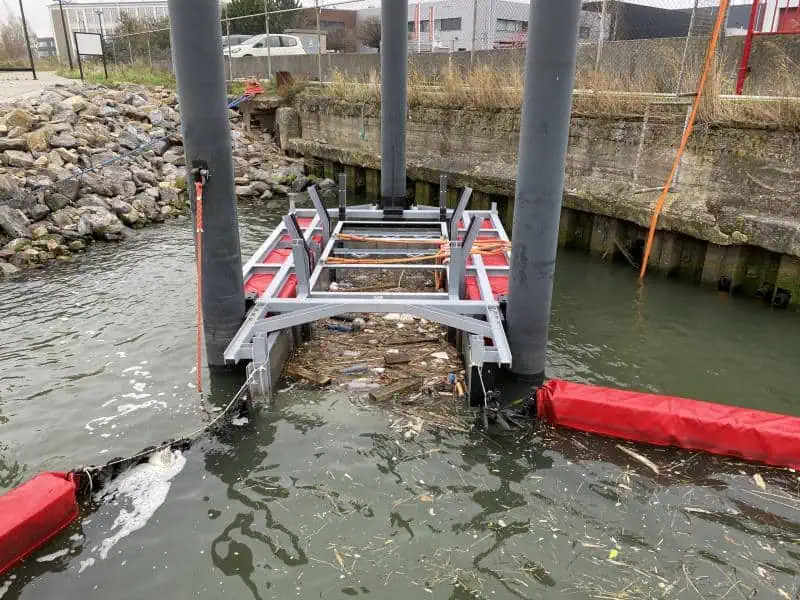Allseas and Rijkswaterstaat have collected 462 kilos of floating waste from the Nieuwe Maas River during an eleven-month pilot with Catchy, an innovative collection system for macro and large micro plastics. A nice result. But what kind of waste is it exactly? What is the influence of wind on this collection system? And what can we do with the collected waste?
Between August 2020 and July 2021, Catchy has collected floating waste in the Vijfsluizer habour in Schiedam. This waste was analysed; mainly the composition and the quantity was looked into. The possibilities for processing the waste were also examined.
Furthermore, we investigated the effectiveness of Catchy by measuring to what extend the waste that ends up in the Vijfsluizer Harbour was collected by the system.
Results of the pilot
The results show that Catchy structurally collected considerable amounts of waste. During the pilot, the system collected floating waste on the surface as well as one metre under water. It concerns macro plastics (> 5 mm) as well as large micro plastics (> 3 mm).
Every month – 11 times between August 2020 and July 2021 – the system was emptied and an average weight of 42 kilos (dry weight) was collected and analysed.
About half of the weight (45%) consisted of biomass such as branches, leafs, reed, etc. The other half consisted of non-biological materials such as processed wood (planks and pallets). About 27% of the non-biological waste collected by Catchy consisted of plastic, 44% consisted of processed wood and 29% of other waste such as glass and metal.
During the pilot, more than 10,200 of non-organic waste objects were collected. About 90% consisted of plastic objects such as straws, bottle caps, and (pieces of) foils. It is estimated that around 170,000 plastic and Styrofoam pellets were collected.
Effectiveness of Catchy
The southwest wind has a major effect on the extent to which the floating waste of the Nieuwe Maas River ends up in the Vijfsluizer Harbour. During monitoring, we installed tracers in the Nieuwe Maas; coloured floating objects to be able to determine how and in which direction waste would flow through the water under the influence of wind direction and current. More than 60% of these tracers were collected by Catchy through the southwest wind. If the wind came from the opposite direction, the tracers would not float into the Vijfsluizer Harbour and into the system.
Furthermore, measurements have shown that in the Vijfsluizer Harbour, more waste is floating on the water surface than deeper into the water column.
At lot of waste can be recycled
A large part of the floating waste collected during the pilot with Catchy can be recycled. 69% of the collected plastic items are bigger than 25 mm, consist of hard materials such as polypropylene (PP) and polyethylene (PE) and can be recycled with existing techniques. Smaller waste particles that are more difficult to separate from biomass waste are a limiting factor in the cost-effective recycling of plastic waste from rivers.
Allseas will conduct more research about this subject in the coming months.
Allseas continues with Catchy
The pilot phase for Catchy is now completed. During this period, Rijkswaterstaat and Allseas gained a great deal of knowledge and shared results. Allseas will continue with this project. Catchy will therefore remain in the Vijfsluizer Harbour to collect waste from the Nieuwe Maas before it can spread to the neighbouring nature reserve and the North Sea.
Wijnand Kooring, project leader Catchy Rijkswaterstaat: “I look back on this pilot with Allseas in a very positive way. Together, we have learned a lot on how to collect floating waste from waters.”
Elise Blondel, project leader Catchy Allseas: “We are very happy with the system and with the results achieved during this pilot project. About 10,000 pieces of plastics and nearly 170,000 pieces of granulate were captured and analysed in 11 months. This has taught us a lot about the composition and origin of the waste in the Nieuwe Maas.”
The Catchy project has received funding from the LIFE programme of the European Union as well as from the Delta fund.
Read more about Allseas’ efforts to rid rivers of waste before it can spread to the ocean.













